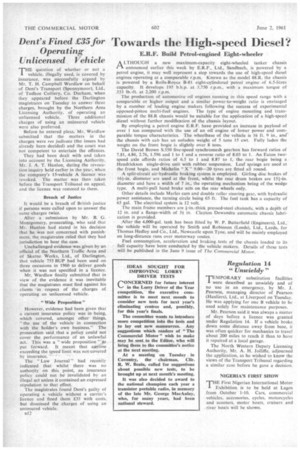Towards the High-speed Diesel?
Page 46

If you've noticed an error in this article please click here to report it so we can fix it.
E.R.F. Build Petrol-engined Eight-wheeler
ALTHOUGH a new maximum-capacity eight-wheeled tanker chassis announced earlier this week by E.R.F., Ltd., Sandbach, is powered by a petrol engine, it may well represent a step towards the use of high-speed diesel engines operating at a comparable r.p.m. Known as the model 88.R. the chassis is powered by a Rolls-Royce B-81 eight-cylindered 'petrol engine of 6.5-litres capacity. It develops 195 b.h.p. at 3.750 r.p.m., with a maximum torque of
333 lb.-ft. at 2200. r.p.m.
The production of automotive oil engines running in this speed range with a comparable or higher output and a similar power-to-weight ratio is envisaged by a number of leading engine makers following the success of experimental opposed-piston multi-fuel engines. The type of engine mounting and transmission of the 88.R chassis would be suitable for the application of a high-speed diesel without further modification of the chassis layout.
By employing a petrol engine E.R.F. have provided an increase in payload of over 1 ton compared with the use of an oil engine of lower power and comparable torque characteristics. The wheelbase of the vehicle is 16 ft. 9 in., and the chassis with cab has an unladen weight of 5 tons 15 cwt. Fully laden the weight on the front bogie is slightly over 8 tons.
The David Brown S.550 five-speed synchromesh gearbox has forward ratios of 7.81, 4.86, 2.76, 1.596 and I to 1 and a reverse ratio of 8.03 to 1. An Eaton twospeed axle affords ratios of 6.5 to I and 8.87 to 1, the rear bogie being a Hendrickson single-drive unit with rubber suspension. Leaf springs are used at the front bogie, and Michelin "X" 9.00-20 tyres are fitted all round.
A split-circuit air-hydraulic braking system is employed. Girling disc brakes of 164-in. diameter are used at the front, whilst the rear drum brakes are 154-in. diameter and have a width of 7 in., the operating mechanism being of the wedge type. A multi-pull hand brake acts on the rear wheels only.
Other details include Marles cam and double roller steering gear, with hydraulic power assistance, the turning circle being 65 ft. The fuel tank has a capacity of 65 gal. The electrical system is 12 volt.
The main frame members are 4-in.-thick pressed-steel channels, with a depth of 12 in. and a flange-width of 34 in. Clayton Dewandre automatic chassis lubrication is provided.
After the 4,000-gal. tank has been fitted by W. P. Butterfield (Engineers). Ltd„ the vehicle will be operated by Smith and Robinson (Leeds), Ltd., Leeds, for Thomas Medley and Co., Ltd., Newcastle upon Tyne, and will be mainly employed on long-distance runs over motorway routes.
Fuel consumption, acceleration and braking tests of the chassis loaded to its full capacity have been conducted by the vehicle makers. Details of these tests will be published in the June 9 issue of The Commercial Motor.
















































































































































































